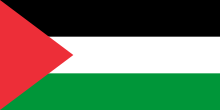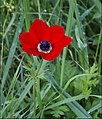
The symbols of Palestine include official and unofficial flags, icons or adopted cultural expressions that may be emblematic, representative or otherwise characteristic of Palestine and of its culture.
The scope of what is included in the symbols of Palestine includes the state flag and its ensign based on the Flag of the Arab Revolt. It also includes Palestinian vexillology and signs used by the Palestinian National Authority. The fida'i is its national anthem. In 2015, the Palestinian Authority adopted the Palestine sunbird as the national bird of the State of Palestine. The Palestinian Authority passport has been described as a 'crucial symbol of nationhood.' Postage stamps and postal history of the Palestinian National Authority also constitute a national symbol. The list of foundational symbols of Palestinian identity include:
- Al Aqsa (compound), particularly the Dome of the Rock
- Handala
- the Palestinian key
- the Nakba
- the Palestinian keffiyeh made famous by Yasser Arafat
- the watermelon
Among the additional objects which are considered to be symbols of the Palestinian nation, is the native Palestinian poppy. Even though the national flower of Palestine is the Faqqua Iris, adopted in 2016, the poppy is red, with black center and green leaves, evoking the primary colors of the Pan-Arabic and Palestinian flag. Jaffa oranges, lemons, olive trees, and the cactus pear (sabr) are also widely used as symbols for the Palestinian nation. Other plants including za'atar (thyme) and handal (colocynth) and traditional Palestinian crafts such as tatreez (Palestinian embroidery) are also considered national symbols.
Gallery
-
 Al Aqsa
Al Aqsa
-
 Watermelon
Watermelon
-
 Keffiyeh
Keffiyeh
-
 Key
Key
-
 Poppy
Poppy
-
 Faqqua Iris
Faqqua Iris
-
 Jaffa oranges
Jaffa oranges
-
 Olive tree
Olive tree
-
 Prickly pear cactus
Prickly pear cactus
-
 Za’atar
Za’atar
-
Handal
-
 Tatreez
Tatreez
-
 Palestine sunbird
Palestine sunbird
References
- The Palestinian People: A History - Page 392, Baruch Kimmerling - 2009
- "Palestine adopts sunbird as emblem for exported goods". www.aa.com.tr.
- The First Palestinian Bird Migration Festival Archived 2011-08-25 at the Wayback Machine, Palestine Wildlife Society. Retrieved 29 July 2009.
- Jordan Times, 25 Jan. 1995
- Cohen, Hillel (2017). "The Temple Mount/al-Aqsa in Zionist and Palestinian National Consciousness: A Comparative View". Israel Studies Review. 32 (1). Berghahn Books: 1, 8–9, 17. doi:10.3167/isr.2017.320102. eISSN 2159-0389. ISSN 2159-0370. JSTOR 45238302.
The holy site known to Jews as the Temple Mount and to Muslims as Haram al-Sharif or al-Aqsa is central to both the Jewish and Palestinian Arab national movements… Al-Aqsa can thus be seen as the central symbol of Palestinian nationalism... One should bear in mind that since the emergence of nationalism in the Arab world, important schools have insisted on separation of religion and state. In addition, a degree of tension exists between al-Aqsa's two aspects, as a national symbol uniting Palestinian Muslims and Christians, and al-Aqsa as an exclusively Muslim symbol. In other words, the intentions of Palestinians united under the banner of al-Aqsa are not all the same… For the Palestinians, al-Aqsa is a singular focal point of self-respect and religious destiny. This heightens their commitment to the site, without connection to their religious affiliation (Muslim or Christian) or level of religious belief and observance.
- Reiter, Yitzhak (2013). "Narratives of Jerusalem and its Sacred Compound". Israel Studies. 18 (2). Indiana University Press: 115–132. doi:10.2979/israelstudies.18.2.115. ISSN 1084-9513. S2CID 143739581.
This article deals with the employment of religious symbols for national identities and national narratives by using the sacred compound in Jerusalem (The Temple Mount/al-Aqsa) as a case study. The narrative of The Holy Land involves three concentric circles, each encompassing the other, with each side having its own names for each circle. These are: Palestine/Eretz Israel (i.e., the Land of Israel); Jerusalem/al-Quds and finally The Temple Mount/al-Aqsa compound...Within the struggle over public awareness of Jerusalem's importance, one particular site is at the eye of the storm—the Temple Mount and its Western Wall—the Jewish Kotel—or, in Muslim terminology, the al-Aqsa compound (alternatively: al-Haram al-Sharif) including the al-Buraq Wall... "Al-Aqsa" for the Palestinian-Arab-Muslim side is not merely a mosque mentioned in the Quran within the context of the Prophet Muhammad's miraculous Night Journey to al-Aqsa which, according to tradition, concluded with his ascension to heaven (and prayer with all of the prophets and the Jewish and Christian religious figures who preceded him); rather, it also constitutes a unique symbol of identity, one around which various political objectives may be formulated, plans of action drawn up and masses mobilized for their realization
- Palestinian Academic Society for the Study of International Affairs; Tim Marshall: "Many people believe that the mosque depicted is called the Al-Aqsa; however, a visit to one of Palestine's most eminent intellectuals, Mahdi F. Abdul Hadi, clarified the issue. Hadi is chairman of the Palestinian Academic Society for the Study of International Affairs, based in East Jerusalem. His offices are a treasure trove of old photographs, documents, and symbols. He was kind enough to spend several hours with me. He spread out maps of Jerusalem's Old City on a huge desk and homed in on the Al-Aqsa compound, which sits above the Western Wall. "The mosque in the Al- Aqsa flag is the Dome of the Rock. Everyone takes it for granted that it is the Al-Aqsa mosque, but no, the whole compound is Al-Aqsa, and on it are two mosques, the Qibla mosque and the Dome of the Rock, and on the flags of both Al-Aqsa Brigades and the Qassam Brigades, it is the Dome of the Rock shown," he said. Tim Marshall (4 July 2017). A Flag Worth Dying For: The Power and Politics of National Symbols. Simon and Schuster. pp. 151–. ISBN 978-1-5011-6833-8.; Mahdi Abdul Hadi, Mahdi Abdul Hadi Archived 2020-02-16 at the Wayback Machine: "Al-Aqsa Mosque, also referred to as Al-Haram Ash-Sharif (the Noble Sanctuary), comprises the entire area within the compound walls (a total area of 144,000 m2) - including all the mosques, prayer rooms, buildings, platforms and open courtyards located above or under the grounds - and exceeds 200 historical monuments pertaining to various Islamic eras. According to Islamic creed and jurisprudence, all these buildings and courtyards enjoy the same degree of sacredness since they are built on Al-Aqsa's holy grounds. This sacredness is not exclusive to the physical structures allocated for prayer, like the Dome of the Rock or Al-Qibly Mosque (the mosque with the large silver dome)"
- Faber, Michel (10 July 2009). "Review: A Child in Palestine: The Cartoons of Naji al-Ali". The Guardian.
- Alazzeh, Ala (2012). "Abu Ahmad and His Handalas". In LeVine, Mark; Shafir, Gershon (eds.). Struggle and Survival in Palestine/Israel. University of California Press. pp. 427–444. ISBN 978-0-520-26252-2. JSTOR 10.1525/j.ctt1ppwdk.34.
…one of the most popular symbols of Palestinian nationalism.
- Meital, Y.; Rayman, P. (2017). Recognition as Key for Reconciliation: Israel, Palestine, and Beyond. Social, Economic and Political Studies of the Middle East and Asia. Brill. ISBN 978-90-04-35580-4.
Michal concedes the fact that Israelis do the same thing to the memory of the Nakba when saying "it was in 1948, enough talking about the past, let's talk about the future." When the Palestinians come with their keys , she says, "it's the same thing, it's a memory still burning in the hearts of families
- Fisk, Robert (2018-06-28). "'I spoke to Palestinians who still hold the keys to homes they fled decades ago – many are still determined to return'". The Independent.
Keys must always be the symbol of the Palestinian "Nakba" – the "disaster" – the final, fateful, terrible last turning in the lock of those front doors as 750,000 Arab men, women and children fled or were thrown out of their homes in what was to become the state of Israel in 1947 and 1948.
- ^ Haddad, Mohammed; Antonopoulos, Konstantinos; Ali, Marium (20 November 2023). "Symbols of Palestine". aljazeera.com. Retrieved 6 January 2024.
- ^ Abufarha, Nasser (2008). "Land of symbols: cactus, poppies, orange and olive trees in Palestine". Identities. 15 (3): 343–368. doi:10.1080/10702890802073274. ISSN 1547-3384. Retrieved 6 January 2024.
- Rios, Pedro (28 October 2015). "Reflections on Palestine: Symbols of Homeland". San Diego Free Press. Retrieved 6 January 2024.
- Khalil, Shahd Haj (8 September 2022). "Olive tree, za'atar, cactus: Palestine's symbolic plants and the meanings behind them". Middle East Eye. Retrieved 6 January 2024.